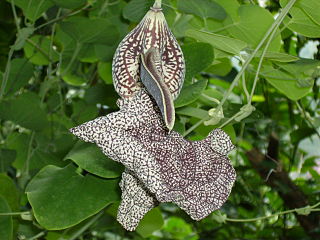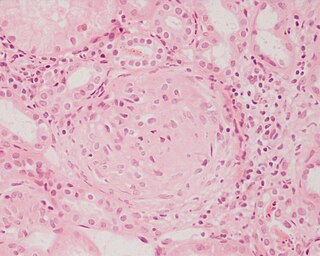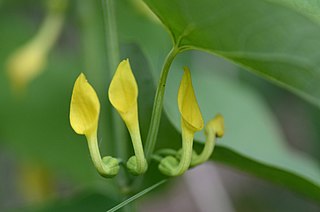
Proteinuria is the presence of excess proteins in the urine. In healthy persons, urine contains very little protein, less than 150 mg/day, and therefore an excess is suggestive of illness. Excess protein in the urine often causes the urine to become foamy. Severe proteinuria can cause nephrotic syndrome in which there is worsening swelling of the body.

Nephrotic syndrome is a collection of symptoms due to kidney damage. This includes protein in the urine, low blood albumin levels, high blood lipids, and significant swelling. Other symptoms may include weight gain, feeling tired, and foamy urine. Complications may include blood clots, infections, and high blood pressure.

Nephritis is inflammation of the kidneys and may involve the glomeruli, tubules, or interstitial tissue surrounding the glomeruli and tubules. It is one of several different types of nephropathy.

Aristolochic acids are a family of carcinogenic, mutagenic, and nephrotoxic phytochemicals commonly found in the flowering plant family Aristolochiaceae (birthworts). Aristolochic acid (AA) I is the most abundant one. The family Aristolochiaceae includes the genera Aristolochia and Asarum, which are commonly used in Chinese herbal medicine. Although these compounds are widely associated with kidney problems, liver and urothelial cancers, the use of AA-containing plants for medicinal purposes has a long history. The FDA has issued warnings regarding consumption of AA-containing supplements.

Kidney disease, or renal disease, technically referred to as nephropathy, is damage to or disease of a kidney. Nephritis is an inflammatory kidney disease and has several types according to the location of the inflammation. Inflammation can be diagnosed by blood tests. Nephrosis is non-inflammatory kidney disease. Nephritis and nephrosis can give rise to nephritic syndrome and nephrotic syndrome respectively. Kidney disease usually causes a loss of kidney function to some degree and can result in kidney failure, the complete loss of kidney function. Kidney failure is known as the end-stage of kidney disease, where dialysis or a kidney transplant is the only treatment option.

IgA nephropathy (IgAN), also known as Berger's disease, or synpharyngitic glomerulonephritis, is a disease of the kidney and the immune system; specifically it is a form of glomerulonephritis or an inflammation of the glomeruli of the kidney. Aggressive Berger's disease can attack other major organs, such as the liver, skin and heart.

Aristolochia is a large plant genus with over 500 species that is the type genus of the family Aristolochiaceae. Its members are commonly known as birthwort, pipevine or Dutchman's pipe and are widespread and occur in the most diverse climates. Some species, like A. utriformis and A. westlandii, are threatened with extinction.

Glomerulonephritis (GN) is a term used to refer to several kidney diseases. Many of the diseases are characterised by inflammation either of the glomeruli or of the small blood vessels in the kidneys, hence the name, but not all diseases necessarily have an inflammatory component.

Diabetic nephropathy, also known as diabetic kidney disease, is the chronic loss of kidney function occurring in those with diabetes mellitus. Diabetic nephropathy is the leading causes of chronic kidney disease (CKD) and end-stage renal disease (ESRD) globally. The triad of protein leaking into the urine, rising blood pressure with hypertension and then falling renal function is common to many forms of CKD. Protein loss in the urine due to damage of the glomeruli may become massive, and cause a low serum albumin with resulting generalized body swelling (edema) so called nephrotic syndrome. Likewise, the estimated glomerular filtration rate (eGFR) may progressively fall from a normal of over 90 ml/min/1.73m2 to less than 15, at which point the patient is said to have end-stage renal disease. It usually is slowly progressive over years.
Nephrotoxicity is toxicity in the kidneys. It is a poisonous effect of some substances, both toxic chemicals and medications, on kidney function. There are various forms, and some drugs may affect kidney function in more than one way. Nephrotoxins are substances displaying nephrotoxicity.

Nephritic syndrome is a syndrome comprising signs of nephritis, which is kidney disease involving inflammation. It often occurs in the glomerulus, where it is called glomerulonephritis. Glomerulonephritis is characterized by inflammation and thinning of the glomerular basement membrane and the occurrence of small pores in the podocytes of the glomerulus. These pores become large enough to permit both proteins and red blood cells to pass into the urine. By contrast, nephrotic syndrome is characterized by proteinuria and a constellation of other symptoms that specifically do not include hematuria. Nephritic syndrome, like nephrotic syndrome, may involve low level of albumin in the blood due to the protein albumin moving from the blood to the urine.

Ochratoxins are a group of mycotoxins produced by some Aspergillus species and some Penicillium species, especially P. verrucosum. Ochratoxin A is the most prevalent and relevant fungal toxin of this group, while ochratoxins B and C are of lesser importance.

Ochratoxin A—a toxin produced by different Aspergillus and Penicillium species — is one of the most-abundant food-contaminating mycotoxins. It is also a frequent contaminant of water-damaged houses and of heating ducts. Human exposure can occur through consumption of contaminated food products, particularly contaminated grain and pork products, as well as coffee, wine grapes, and dried grapes. The toxin has been found in the tissues and organs of animals, including human blood and breast milk. Ochratoxin A, like most toxic substances, has large species- and sex-specific toxicological differences.

Analgesic nephropathy is injury to the kidneys caused by analgesic medications such as aspirin, bucetin, phenacetin, and paracetamol. The term usually refers to damage induced by excessive use of combinations of these medications, especially combinations that include phenacetin. It may also be used to describe kidney injury from any single analgesic medication.

Aristolochia clematitis, the (European) birthwort, is a twining herbaceous plant in the family Aristolochiaceae, which is native to Europe. The leaves are heart shaped and the flowers are pale yellow and tubular in form. The plant seeks light by ascending the stems of surrounding plants.
Diffuse proliferative glomerulonephritis (DPGN) is a type of glomerulonephritis that is the most serious form of renal lesions in SLE and is also the most common, occurring in 35% to 60% of patients. In absence of SLE, DPGN pathology looks more like Membranoproliferative glomerulonephritis
Sickle cell nephropathy is a type of nephropathy associated with sickle cell disease which causes kidney complications as a result of sickling of red blood cells in the small blood vessels. The hypertonic and relatively hypoxic environment of the renal medulla, coupled with the slow blood flow in the vasa recta, favors sickling of red blood cells, with resultant local infarction. Functional tubule defects in patients with sickle cell disease are likely the result of partial ischemic injury to the renal tubules.

Samoyed hereditary glomerulopathy (SHG) is a hereditary, X-linked, noninflammatory disease of the renal glomeruli, occurring in the Samoyed breed of dog. The disease has been shown to be a model for Alport syndrome in humans in that the disease resembles that of the human disease. Because of this, it is sometimes referred to by the name given to the disease in humans when referring to the conditions in Samoyed dogs. Alternatively, it may also be known as X-linked hereditary nephritis. Genetically, the trait is inherited as a sex-linked, genetically dominant disease, and thus affects male dogs to a greater degree than female dogs, since males only have one X chromosome.
Mesoamerican nephropathy (MeN) is an endemic, non-diabetic, non-hypertensive chronic kidney disease (CKD) characterized by reduced glomerular filtration rate (GFR) with mild or no proteinuria and no features of known primary glomerular diseases. MeN is prevalent in agricultural communities along the Pacific Ocean coastal lowlands Mesoamerica, including southern Mexico, Guatemala, El Salvador, Nicaragua, Honduras and Costa Rica. Although most cases have been described among agricultural workers, MeN has also been described in other occupations, including miners, brick manufacturers, and fishermen. A common denominator among these occupations is that they are outdoor workers who reside in rural areas in hot and humid climates.
Uddanam nephropathy is a chronic kidney disease (CKD) that is endemic in the Indian region of Uddanam in Andhra Pradesh. Nephropathy on an endemic scale was first reported in Andhra Pradesh in the 1990s. In 2015, over 34,000 cases of kidney disease were recorded in the region, and it was estimated that at least 4,500 people had died from it in the last ten years. Its cause has not been found yet, and according to the WHO, it is "the least understood and the least publicized" nephropathy of unknown origin.















